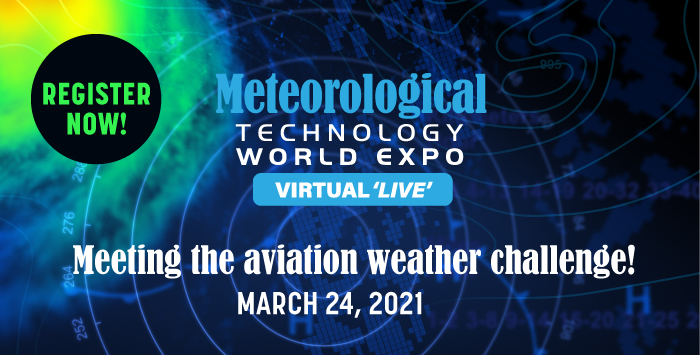As a specialized agency of the United Nations, the World Meteorological Organization (WMO) plays a leading role in the development and implementation of new and improved meteorological services for aviation. At the upcoming, online Meteorological Technology World Expo Conference for Aviation Meteorology (March 24, 2021), the WMO will host an exclusive science session for aviation applications. A panel discussion and Q&A will follow the session.
The WMO Services Commission is charged with leading and coordinating the promotion, development and implementation of globally consistent and user-focused services, based on the application of the best environmental science and research from all over the world and underpinned by a vast array of international weather monitoring networks.
A unique WMO Science for Aviation Applications session will feature presentations and a panel discussion that, based on international examples of good practice, aims to promote a discussion on how the science-to-services value chain for aeronautical meteorology works – and why the collaborations and partnerships that underpin this are so important.
The WMO’s Stephanie Wigniolle, scientific officer, services for aviation division, and Greg Brock, head of the services for aviation division, will cover the scientific advancement supporting evolving service needs. They will provide an overview of the prevailing drivers for change and will explore several key areas of ongoing meteorological scientific research. They will also provide insight into the potential impacts of climate change and variability on aviation operations now and in the future.
The session will also draw upon the Aviation Research & Demonstration Project (AvRDP) conducted by the WMO between 2015 and 2019 to demonstrate the capability of nowcasting and mesoscale modeling techniques in support of the development of next-generation meteorological information for international air navigation.
Building on the success of AvRDP Phase I, WMO’s Research Board has recently approved a follow up to the AvRDP, named AvRDP Phase II, leveraging advances in meteorological observing, seamless nowcasting and forecasting research, as well as artificial intelligence.
Listen to Dr Estelle De Coning, head of the World Weather Research Program (WWRP) at WMO and her colleagues at Hong Kong Observatory, Sharon Lau and Dr Ping Wah (Peter) Li, as they explain how AvRDP Phase II will focus on convection-related hazards and study the use of advance techniques such as ensembles and machine learning methodology in the provision of risk.
Online conference participants will also hear from Minna Huuskonen, scientific officer, Observations & Measurement Networks Division, WMO, who will explain how the WMO and IATA have entered a collaboration for the purposes of managing and evolving the global Aircraft Meteorological DAta Relay (AMDAR) program and expanding it to provide data coverage in areas of the globe where data gaps currently exist. The availability and different sources of aircraft-based observations (ABO) will also be discussed with the aim of achieving increased availability of upper air data for data users and meteorological services.
Delegates will also receive exclusive updates on the World Area Forecast System, which produces significant weather forecast charts, plus gridded forecasts of wind, temperature, relative humidity, turbulence, icing and thunderstorms. The Significant Weather Charts, best suited for situational awareness, will be vastly improved in 2023. The gridded forecasts, for use by flight planning systems, will also be improved over the next few years. The coming improvements will provide more consistent, detailed and accurate information, argues Matt Strahan, international operations chief at NOAA – and the user community will need to update their systems in order to make use of the improvements.
Finally, do you remember Eyjafjallajokull? Qualitatively, the threat volcanic ash poses to jet engines has been known since the early 1950s, but it took the eruption of Eyjafjallajokull in 2010 to highlight the need for a quantitative understanding of how volcanic ash affects them. Even some years after the 2010 crisis, aviation operated a policy of volcanic ash total avoidance. Rory Clarkson, engine environmental protection – associate fellow at Rolls-Royce, will describe the efforts undertaken since 2010 to gain a sufficiently robust quantitative understanding of the impacts of volcanic ash on jet engines, to allow some level of volcanic ash exposure during flight operations.
See the full conference program and register FREE now!




